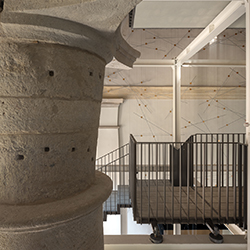
Ca’ Scarpa
Fondazione Benetton Studi Ricerche has had a new exhibition space since October 2020 in Treviso in via Canova 11.
Intended for cultural activities, Ca’ Scarpa now represents a new piece in the mosaic of places for culture in the historic centre of Treviso desired by Luciano Benetton.
«The first building of the intricate complex of the former Revenue Office of Treviso [following its acquisition by Edizione Property in 2018] to be restored was the Santa Maria Nova Church, is now inaugurated with the name Ca’ Scarpa. Hereby declaring its intention to serve as an exhibition space and vital centre of activities that are realised, within the framework of Fondazione Benetton Studi Ricerche, thanks to the collaboration of Carlo and Tobia Scarpa. Therefore not a museum, but an open place that has as its prime reference the cultural legacy and the stimuli stemming from these two men linked to the history and places of the landscape of Treviso, not only through architecture – in fact, considering the thirty years of the Carlo Scarpa Garden Prize -, looking towards the city, but also the international cultural attraction that Carlo and Tobia Scarpa represent.
The very posture of the building in the urban structure declares the core role that the former church has in relation to the city and the various places that represent the extensive network of Benetton’s cultural patrons in Treviso. On one side the building extends beyond the perimeter of a large block that already features, on the opposite facade, the restoration of the Court buildings and the Habsburg prisons (now the Gallerie delle Prigioni) that is now serves urban use and public perception with a surprising succession of cloisters and courtyards; on the other side, Santa Maria Nova marks, with its refound presence, the visible and invisible flow of water along an artificial canal (or Siletto canal) which features the other monuments of this widespread presence of recovered buildings transformed into cultural venues: consider, in particular, upstream, the continuity of palazzi Bomben and Caotorta with the water-side garden (now the Fondazione Benetton Studi Ricerche site), the Gallerie delle Prigioni along the artificial canal and lastly, further down, the San Teonisto church: all buildings that Tobia Scarpa and the patrons of Luciano Benetton frequented. It therefore becomes interesting to re-consider the history of Santa Maria Nova in its evolution from place of worship to actual “warehouse” with a structure from the early nineteenth century then the twentieth century, in the context of an almost labyrinth-like conventual framework that has been suppressed, adapted to military, hospital and barracks life, repeatedly damaged and destroyed by wars and lastly, the systematic invasion of paper and spaces linked to the Revenue Office. The church, which for two centuries remained unchanged in its role as a deposit, is now the first building of the great complex of the former Revenue Office to serve the city’s public life without hiding, thanks to Scarpa’s project, its long-standing vocation for temporary storage, rather than conservation.
The building that we see today took shape in the second half of the Sixteenth century, inside a vast compartment that brings together the most ancient benedictine Ognissanti monastery and that of Santa Maria Nova, with the church of the same name. All of this, in the Napoleon era, followed the fates of the suppression of religious orders, becoming first a military hospital and then a barracks. The church went through various functional adaptations with the construction of floors and internal partitions, taking on the configuration that we see today also when, with the Kingdom of Italy, it served as barracks, and was not damaged by bombs in the First and Second World Wars. The destructions, in the post-war era, led to the project to adapt the complex into the Revenue Office and later, in the Eighties, the church had all of its nineteenth-twentieth century superstructures removed, recovering its original masonry structure, to house the three-storey metal structure of a new “printed materials depot”, more functional and stable than the previous one.
Thanks to Tobia Scarpa’s project, maintaining and interacting with this very recent structure, Ca’ Scarpa was inaugurated on Saturday 24 October 2020 with the Cappadocia exhibition. The landscape in the core of the rock, dedicated to the place chosen at the thirty-first edition of the International Carlo Scarpa Garden Prize».
Luigi Latini, Ca’ Scarpa in Treviso. The city and the sites of Benetton’s patrons for culture,
taken from «Casabella», lxxxiv, 913, September 2020, pages 55-56
